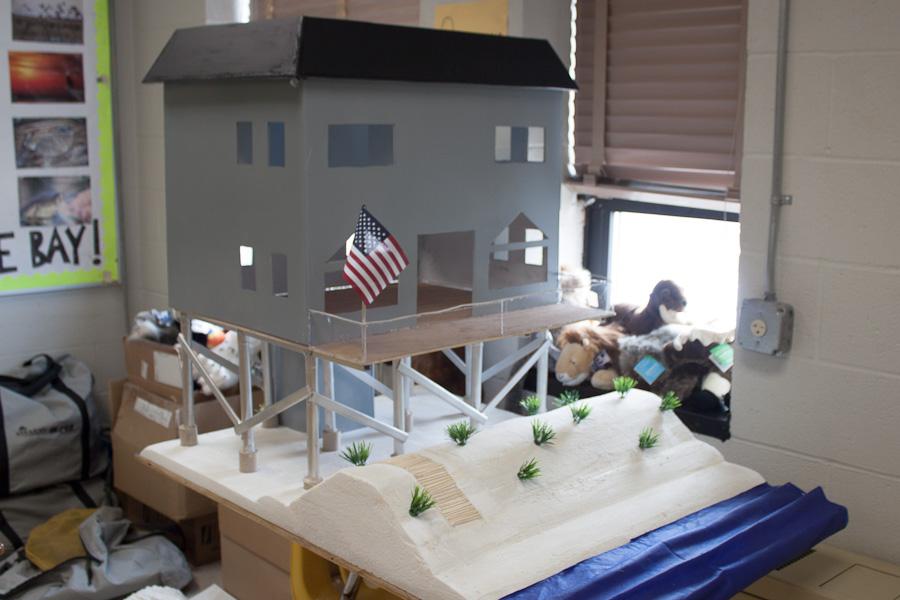AP Human Geography students construct model houses
Freshmen Emily Schiavone and Allie Taylor worked on this gray beach house as part of a AP Human Geography project. It was supposed to represent a beach house in Bethany Beach, Delaware.
What can you make with hot glue, paper, cellophane, tape, acrylic paint, clay, sand, poster board, and balsa wood? A traditional Chinese house, of course. Or at least a small model of one.
As part of a yearly project, AP Human Geography teacher John Hughes had his students build models of houses. At the end, the students had to present their houses to the class and answer questions about them.
“Basically, we had to research a specific type of house and recreate it in a model and write a paper discussing the history, construction, geographic influence, and advantages and disadvantages of structure,” freshman Emma Gromacki said. “We, [freshman] Elizabeth Butz and I, were allowed to pick our topic but had to decide on the spot, and we randomly picked a Chinese traditional house [called siheyuan], not knowing what we got ourselves into.”
“The purpose of this project is to see the effects of geography on the architecture of houses,” Hughes said.
The students worked on all different types of houses. Freshmen Emily Schiavone and Allie Taylor worked on a gray beach house that was supposed to represent a beach house in Bethany Beach, Delaware.
“I learned how to build a house and all the steps that it takes to create a sustainable living space. I learned all the different procedures and codes that are needed to be passed in order to build a home,” Schiavone said.
According to Hughes, this project is helpful for “real life” as it works with “construction, design, and materials.”
“We learned a lot about ancient Chinese culture and how greatly culture and geography influenced the architecture. Many Chinese were [Confucian] in the Beijing area, so they believed in something called “feng shui,” a force that could connect one with nature, ancestors, and spirits. It was really important that the buildings were symmetrical, faced a certain way so the sun would rise and set a specific way in relation to the house, and had trees and other natural substances in it, all to connect with nature. I thought this was really cool,” Gromacki said.
Gromacki also found it interesting that “the stress on men being superior to women was apparent in the building, in that the unmarried daughters who were disgraced and not cared about were hidden away in the farthest building from the entrance to keep them away from people and company.”
For Gromacki though, her favorite part of the project was the actual building part.
“I have always loved to build things, as my many Lego Architecture and other building sets I have prove. And for the first time my creativity, drafting and building skills were put to the test for a school project,” she said.
For Schiavone, her “favorite part was getting to learn about beach houses and how they are constructed because I love visiting the beach and seeing all the interesting houses there.”
The houses, however, took a lot of time.
According to Gromacki, they spent an hour on research, two hours on planning, seven hours on the actual building, and an hour and a half on the paper. All of this combined took 11 1/2 hours.
Gromacki said only after research did they figure out how they were going to build a house from “scratch.” She said it was “an easy decision because our main resource, balsa wood, is easy to cut but still strong.”
“I found a picture of the house and drew a floor plan on the poster board. Once this was completed, [Butz] painted the wood grey because the house couldn’t be too flashy otherwise it wasn’t focused on nature, and I cut the wood and hot glued the wood pieces down on the drawing,” she said.
They also added movable doors and stairs for the entrance to each important building. “Even though all the doors worked back then, it was an easy way to show the importance of some buildings over others,” Gromacki said.
“From there [Butz] created the courtyards, with clay and sand walkways and the two ponds. These aspects were very important in the house. Finally, I cut wood so that when I glued the textured paper on, it would create the famous curved Chinese roofs.”
According to Gromacki, in her research she found that “these buildings are still standing today because the Chinese invented the notch style of architecture, which can withstand an earthquake up to eight on the Richter Scale.”
After completing the project Schiavone said that “I advise students to always try their hardest and put as much effort into schoolwork as possible.”
Hope Kelly is the Editor in Chief for The Patriot and jcpatriot.com.



